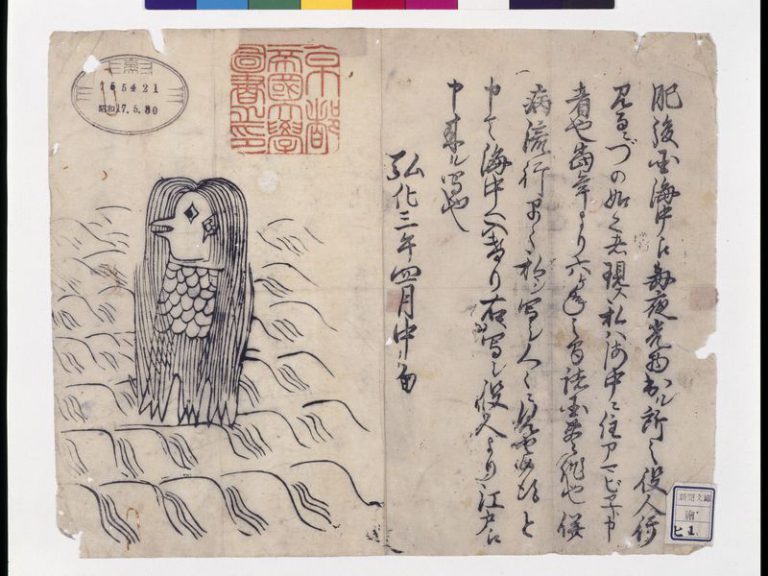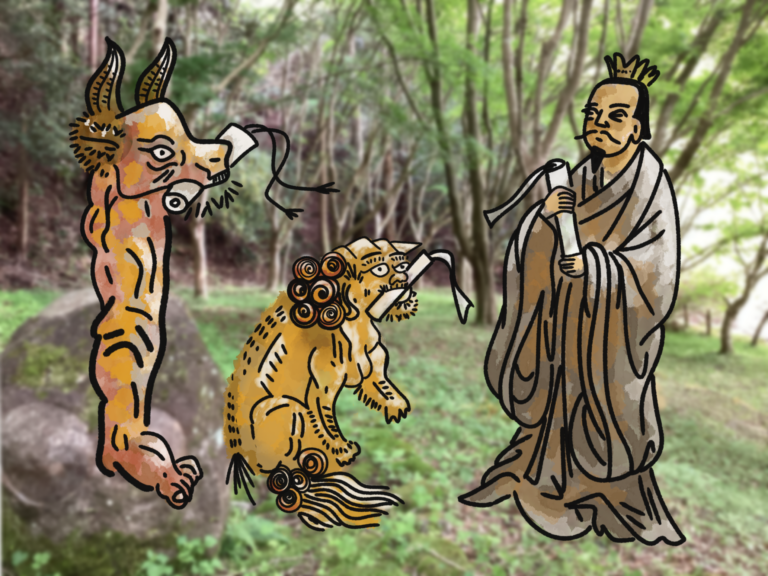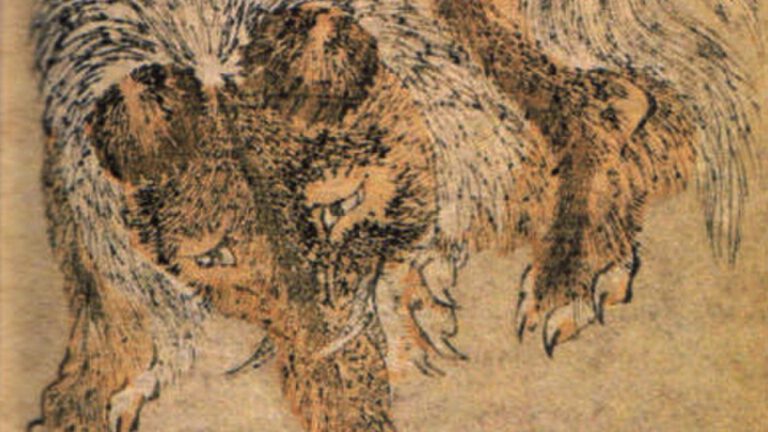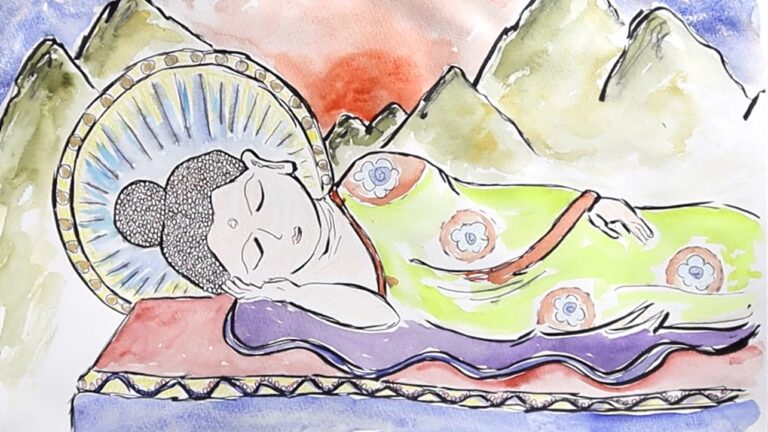Hey hey, this is Thersa Matsuura and you’re listening to Uncanny Japan.
Something Not Human Following You?
So why is it every time you’re out walking alone in the foothills of Japan at night, you have the overwhelming feeling you’re being followed. Not by something truly horrible — like a person — but something different, not of this world. Step step step. Beto beto beto. You turn around but no one’s there. You continue on. Step Step step. Beto beto beto. You stop again, turn quicker this time. Still, no one. Nothing. You speed up. It speeds up. You slow down. It slows down. All right, now you’re really scared. What should you do? What if the sound isn’t beto beto beto what if it’s more of a teke teke teke?
Intro
I’m author Thersa Matsuura and this is Uncanny Japan, the podcast about yokai, folktales and curious cultural quirks. Hello, how are you? In case you missed it or momentarily forgot or this is your first time listening to the show, my new book, The Book of Japanese Folklore is out now. The hard back is really beautiful, but there’s also the audio version, read by me. And if you’ve already picked on up and would like to leave a review that is also a huge help. Thank you so much.
So in today’s episode I’m going to tell you about the Beto beto-san and the Teke Teke, two creatures who both get their kicks out of following you around but with entirely different intentions.
First, the Beto Beto-san
We’ve established your out alone at night, walking around. But what is this thing stalking you that is distinctly, not human? Well, as long as the footsteps don’t sound like teke teke (I’ll get into that a little bit later), you are probably safe. That’s a beto beto-san galumphing behind you.
Traditionally, there are two notable places for having a beto beto-san appear. The first is Nara Prefecture (Uda-gun) where they were said to frequent dark streets or footpaths at night. The other is Shizuoka Prefecture where they show up on when you’re descending small mountains.
How to Get Rid of it
But there’s no need to worry, this yōkai means no harm. It’s actually kinda adorable. You see, if this does happen and you are unnerved by the whole idea of being tracked by some otherworldly creature you can’t see, there were two remedies. If you’re in Nara you simply move to the side of the path and say: “Beto-beto-san, osaki ni okoshi” (“Beto-beto-san, please go ahead and pass”) or if in Shizuoka: “Osaki ni okoshi” or “Osaki ni dōzo”, meaning basically the same thing. After you! And the Beto beto-san will disappear. Or sometimes it won’t. It’ll move on ahead then say, “If I go any farther it’ll be too dark and I can’t walk.” In that case, lend it your lantern and it’ll be on its way.
What Does it Look Like?
So what does a Beto beto-san look like? Well, it didn’t used to look like anything. It was just a creepy occurrence that happened. The sound of someone following you. Then along came Mizuki Shigeru (of Gegege no Kitaro fame) — who had experienced a Beto beto-san as a child, by the way, but was too frightened to look back. Well, he decided to give this mysterious yōkai a face, or body, or, well, basically a large round thing with a giant smiling, toothy mouth and two legs. It kind of creepy and cute an a lovely relatively new addition to the yōkai cannon.
What Does its Name Mean?
How about that cute name? What does Betobeo-san mean? Let’s work backwards. The “san” part is the honorific for addressing someone. More polite than chan or kun, but less polite than sama or if you’re watching Shogun, you’ll hear a lot, dono.
Next you have beto beto. The onomatopoeia beto beto means sticky. If your eating cotton candy with your fingers? Beto beto. If you’re kneading dough to make a pizza? Beto beto. If you’re stuck at a bus stop in the middle of August under the sweltering summer sun and covered in sweat. Beto Beto.
At first I just assumed the “beto beto” came from the sound of sticky feet on the ground following you. But if you want to describe footsteps walking across damp ground you’d probably say betta betta. Which actually sounds creepier to me. Then I looked more closely at Mizuki sensei’s depiction. His Beto beto-san is wearing geta shoes, which are made of wood. It’s pretty well known that when you walk around in geta you make a karan koron sound. At the very least a more fricative onomatopoeia, not the “be” sound.
Then I read that the name doesn’t come from the sound of footsteps, but from the stickiness of the yokai following you. It’s sticking to YOU as you walk. But even with that image in your head, this timid little creature is harmless. You will not be viciously slaughtered by a Beto beto-san.
What if Teke Teke Sound Following You?
If, however, you’re walking alone at night in a more urban environment and the sound you hear isn’t beto beto, but teke teke. Well, THEN you should you be alarmed. You might as well make your peace with whatever god or gods and goddesses you believe in, because this creepy stalker is way messed up and your time on earth is probably very short at this point and you’re going to die an excruciating death.
The Teke Teke has so much written about it and all of it not that old. I’ll try and cover the basics and make some sense of it. Just know that there are loads of variations one more gruesome and awful than the next. Some detailing monstrous acts that happened during or after WWII with the original person who turned into the Teke Teke being anything from a soldier to a postal worker to a young lady name Kashima-san. Often Kashima Reiko.
Kashima-san’s Urban Legend and a Story
I kind of like how someone connected Kashima-san to Kuchisake Onna (remember the woman with the mouth that opens from ear to ear?). They say Kashima-san is the slit-mouthed woman’s real name. Although we never hear anything about Kushisake onna’s feet or bottom half and that is what Teke Teke is all about. Since in the majority of the tales the Teke Teke is female, I’ll call her a she. The gist — with nods to different variations — goes like this.
It was a frigid winter night way up in the northern country (I’ve read Hyogo Prefecture or Hokkaido) and a woman (or junior or high school student) fell (or was pushed or jumped herself in an attempt to take her own life) onto the train tracks. There was no one around to help, a train came, and she was hit and cut completely in half. Miraculously, though, because of the extreme weather, the ends of all those pesky spurting blood vessels immediately froze and she was saved. Well, for a bit anyway. She did end up dying, but before that happened, she had time to search for her missing lower half by using her arms (or elbows) to scuttle around. That where the teke teke name comes from. Pretty unnerving, huh? It’s also the sound after her death, of her ghost desperately searching for her legs. Or if you’re unlucky enough to run across her, it’s the sound of her scrambling toward you and an ungodly speed. Imagine that happening late one night, all by yourself, you hear a sound. Rats in some garbage maybe? You turn.
Versions Number 2
There’s another interpretation that says — after the tragic accident — some station worker — assuming she was dead — threw a blue tarp over her body to hide the scene. But she wasn’t dead. She was still alive. Again, barely clinging to life. She did succumb to the trauma soon after, but not before she had time to grow furious at the callousness of that station attendant. With that emotion seething inside her, she died and became an angry ghost or an onryou.
Her goal in death then became to take revenge on all humanity, one person at a time. Or something like that. She does this by hunting people down. Which is easy when you can move at speeds up to 150 kilometers an hour. That’s even more of a supernatural feat when you consider it’s just her top half doing the chasing, and she has to rely on her two arms for mobility. Teke Teke Teke. The last sound you hear before she slices you in two.
What Does She Do?
How does she slice you in half? Well, sometimes she’s seen brandishing a scythe. But how does she carry a scythe when she’s using her only two arms to speed after her victim? Ha! Don’t let a little thing like logic get in the way of a good urban legend. The tellers of this tale have made the appropriate adjustments. Sometimes she can fly! But if she can fly, why doesn’t she just fly at me, save the wear and tear on her limbs, AND be much more stealthy? Certainly she could kill a lot more people if she could just fly at them, swing her blade and chop them in half. To which I’d answer, well, then her name wouldn’t be Teke Teke, would it? Also, you lose the grotesque visual of a bloody torso scrambling after you at top speed.
Related to Sa-chan, the Song?
It’s all good fun, right? But to me personally just amping up the gross out factor doesn’t make the story scarier. What does make it more chilling though is when I read about the connection to an old children’s song.
There’s a very cute and bitter sweet little nursery ryme called “Sa-chan” in three verses that goes something like this. No, I’m not going to sing.
First verse: “Sachan wa ne, Sachiko tte iun da honto wa ne
dakedo, chichai kara jibun no koto Sachan tte yobundayo
Okashiina Sachan”
English: “Sachan, you know, her real name is Sachiko.
But because she’s small, she calls herself Sachan.
Isn’t that funny, Sachan?
Second verse:
Sachan wa ne, banana ga daisuki honto da yo
dakedo, chichai kara banana wo hanbun shika taberarenai no
kawaisoune Sachan
English:
“Sachan, you know, it’s true she really loves bananas.
But because she’s small, she can only eat half of one.
Poor Sachan”
Third verse:
“Sachan ga ne, touku e itchatte honto kana?
dakedo, chichai kara boku no koto wasurete shimau daro
sabishina Sachan
English:
“Sachan, you know, is going far away, is that really true?
But because she’s small, she’ll probably forget about me.
How lonely, Sachan”.
Such a lovely little story. Then along comes some genius (I’m not being facetious either), someone took this perfectly lovely little tune and added a dreadful fourth verse. Remember four, shi, means death in Japanese.
This one goes:
Sachan, wa ne, densha de ashi wo nakushita yo
dakara, omae no ashi wo morai ni iku yo
konban da you, Sachan.
English:
Sachan, you know, lost her legs in a train accident.
So, she’s coming to take your legs.
Tonight, Sacchan
Now, it’s nice and chilling, not perfect. It deviates from the previous three verses, losing the “dakedo, chichai kara…” “But because she’s small” which I think could be used, because she’s small she moves at incredible speeds. Kowai yo, Sachan. I’m scared. Sachan.
Teke Teke Curse?
One thing you’ll find in the Teke Teke urban legend is if you just hear the story, then you’ll be visited by her and ghastly things will happen. That’s a much used trope that is extremely effective and does a good job of instilling fear. It works in horror, thing The Ring series and Juon, the Grudge. Does anyone remember chain letters? If you get this letter something bad will happen to you, unless you copy it ten times and give it to your friends and family.
But don’t worry, having heard this episode and learned about the Teke Teke, you won’t be visited by one. I promise. Well, unless you are. But then if your particular Teke Teke is worth their salt, we won’t hear about it, will we?
How to Beat the Teke Teke
Here let me give you a fighting chance, just in case. If you are confronted with a Teke Teke, yell Go to hell! (Jigoku ni ochiro!) or Go back to hell (Jigoku ni kaere!). That seems to work. You’ll be spared. If, however, it’s just a Beto beto-san plodding along behind you, politely move aside and let it pass. Or, I don’t maybe stroll along together so you’re not so aloe and have an interesting conversation. I’m sure it’s got some stories to tell.
That’s all for today. Thank you for listening. I’ll talk to you again in two weeks.
Bye bye.






